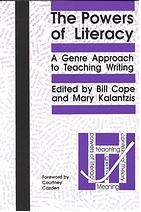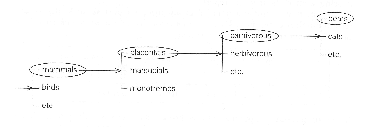
The fact that we can identify stages of a text as having a particular function in its overall organisation is a consequence of the patterning of language choices in each stage. Here we will examine the General Classification stage in a report to show how the grammar makes meaning to construct this stage.
Title: Bears
General Classification: Bears are one type of carnivorous placental mammal. Placental mammals are animals which give birth to live young (rather than laying eggs) and the young at birth are attached to their mothers by a cord. This cord was used to nourish them when they were growing inside their mothers. In this way bears are like people, mice, cattle and whales. Carnivorous mammals are mammals that eat other animals as food and have long sharp eye teeth (canines) which are used for holding and tearing flesh. There are a number of different types of bear: Black bears, Brown bears, Polar bears, Panda bears and some others. Brown bears and Polar bears are described on the following pages.
Let us look first at the grammatical resources for making ideational meanings in the General Classification stage. … [There are] three types of ideational meaning … : doing, meaning and being. An analysis of the clauses in this stage of the report reveals several ‘being’ clauses:
- Bears are one type of carnivorous placental mammal.
- Placental mammals are animals which give birth to live young …
- In this way bears are like people, mice, cattle and whales.
- Carnivorous mammals are mammals that eat other animals as food …
- There are a number of different types of bear: Black bears, Brown bears …
In the first clause bears are related through are to one type of ‘carnivorous placental mammal’. They are thus identified as members of a larger group of animals. In the second clause are works differently. Here it defines what placental mammals are — ‘animals which give birth to live young’. In the fourth clause are works in the same way to define ‘carnivorous mammals’. In the third clause are is used to relate ‘bears’ to other animals they are like — other mammals, including ‘people, mice, cattle and whales’. In the fifth clause the meaning of are can be glossed as exists. It is used to present the different types of bears found throughout the world.
Meanings about ‘being’, in other words, are crucial in building up classifications: in defining, in describing what things are like and in positing the existence of phenomena. These patterns of meaning are crucial for constructing what is in this case a simple scientific classification system and locating bears in this system.
Let us now examine how the meanings about ‘being’ set up particular kinds of relationship between the animals identified in the general classification. In doing this, we are moving our focus to meanings established between items in different clauses. These relations are known as lexical relations. Here is the simple taxonomy built up by the lexical relations and ‘being’ clauses in the General Classification:
Figure: Taxonomy of Animals Constructed in General

The choice of Theme is a choice for textual meaning in the clause. This choice orders elements in the clause in such a way that they play a role in developing the text — its pattern of development as it unfolds from clause to clause. The pattern of choices for Theme in the General Classification is to do with bears and the species they belong to. Setting aside conjunctions, the Themes are as follows (Themes in italics):
Bears are one type of carnivorous placental mammal. Placental mammals are animals which give birth to live young (rather than laying eggs) and the young at birth are attached to their mothers by a cord. This cord was used to nourish them when they were growing inside their mothers. In this way bears are like people, mice, cattle and whales. Carnivorous mammals are mammals that eat other animals as food and have long sharp eye teeth (canines) which are used for holding and tearing flesh. There are a number of different types of bear: Black bears, Brown bears, Polar bears, Panda bears and some others are described on the following pages.
Note that Textual Themes like and are being passed over here, where the focus is on what Halliday calls Topical Themes — Themes which build experiential meaning. Also In this way has been interpreted as a conjunction of manner here (like thus), leaving bears as the Topical Theme. Notice that the animals that function as Theme (compare, bears, placental mammals, the young at birth, bears, carnivorous mammals, Brown bears and Polar bears) are referred to generically. This is another example of how particular language choices make the meanings of the report genre, which deals with whole classes of animals, plants, machines and so on. In this respect reports are different from narratives which deal with individuals.
There is another part of the grammar which needs to be looked at closely in considering how meaning is built up in the General Classification stage of reports. This deals with the participants in the text — the animals, plants, machines that are its focus. This part of the grammar names these participants and gives information about them and constructs the participants as nominal groups. …
Once again, the way meaning is built up in nominal groups is described in functional terms. Let’s look first at the nominal group bears, which is Theme in the first clause. We can identify the function of the words bears as Thing. This is the function label we give to central participant in the nominal group. We can represent the analysis as follows:
|
bears |
|
Thing |
Nominal groups have a potential for building up meaning which extends well beyond this Thing function. Consider the group this cord. The function of this is Deictic (or less technically, Pointer). It selects or points out whatever functions as thing in the nominal group. This group can be analysed as follows:
|
this |
cord |
|
Diectic |
Thing |
The function label ‘Deictic’ is the one used by systemic linguists, but ‘Pointer’ might be a preferable term for use with school students (linguists will be familiar with the technical term ‘deixis’, from the Greek; for school students terms derived from Latin or Anglo-Saxon usually prove more semantically transparent). Teachers who wish to use the grammar with students can make their own decision about which label they will use. …
To introduce the full potential for nominal group meanings, we shall examine two groups that are not part of the Bears report. The first is as follows:
those two old stone cottages with wrought iron balconies
Cottages is Thing in the above group; and there is information about cottages which both precedes and follows it. The first word in the group, those, has the function of Deictic (or Pointer); the second word, two, has the function Numerative, which can be simplified to Number (this simplification makes it transparent that cardinal numerals like one, two, three and so on, fulfil this function — what perhaps becomes less obvious is that the same function is filled by quantity words like many, much, lots of, several and so on — this tension shows the ultimate advantage of the more abstract, less transparent terms). The next word old gives a quality of the cottages. Its function label is Epithet or Short Describer (the significance of short will become apparent below). The function of stone is to subclassify the type of cottage. It is stone, rather than brick or wood. The function of stone in the group is that of Classifier. We can distinguish the function Classifier from that of Epithet by the following grammatical ‘test’: we can intensify the function Epithet by saying things like very old, rather old and so on; but we do not speak in English of a very stone cottage. Another test involves comparative and superlative meanings, which only apply to Epithets; thus we find the older cottages and the oldest cottages but not the stoner cottages or the stonest cottage. But we do find the stoniest path, in which stoniest is the superlative form of the epithet stoney.
If we return to the General Classification of bears, we can examine the structure of some of the nominal groups to see how they build up meanings of classification. The first example is from the opening sentence: Bears are one type of carnivorous placental mammal. This being clause identifies bears as one type of carnivorous placental mammal. The Deictic and Thing of this group, one and type respectively, show that bears are being identified with respect to their classification — in a biologists terms with respect to the relevant taxonomy of living things.
Embedded in its qualifier is the nominal group carnivorous placental mammal, with the functions Classifier and Thing:
|
carnivorous |
placental |
mammal |
|
Classifier |
Classifier |
Thing |
These functions allow the identification to home in on the precise location of bears in this order of things. … Classification is pursued in subsequent sentences, for example: Placental mammals are animals which give birth to live young. … Once again the nominal group structure is used to build up the scientific classification of bears.

[W]e have looked [here] at just a few aspects of how using a functional grammar enables us to understand how meaning is built up in a text. Although we have only considered part of the General Classification stage, we have seen that identifying this stage of the report depends on a patterning of meanings built up through a complex interaction of language choices. This kind of analysis enables us to see how the stages of texts are constructed to function in particular ways. Being able to look at texts in this way is important in teaching students to write different genres. Knowing the stages of the genre and being able to identify them is an important first step. But ultimately teachers need to know as much as possible about how meaning is built up through language in the different stages of the genre. Teachers need to be able to point out characteristic uses of language in a text of a particular genre as we have done with the report genre. Knowledge of how language is used to mean in different genres is particularly important when it comes to giving students positive assistance with their writing. For example, if students are writing a number of sentences to classify and describe an animal, we can demonstrate how the functions of the nominal group structure enable a much more competent build up of information. To take up a constructive and guiding role of this kind, the teacher needs to know how grammar makes meaning in a text.
[W]e have briefly considered the advantages for teachers and students of a functional grammar … [We] have offered a demonstration of some of the ways in which functional grammar can be used to show how meaning is constructed in text. The choice, in other words, is not between grammar and no grammar, as the debate is often publicly voiced. Rather the choice depends, as it should, on the consumer — on what schools want grammar to do.
Martin, J.R. and Joan Rothey. 1993. “Grammar: Making Meaning in Writing.” Pp. 137-153 in The Powers of Literacy: A Genre Approach to Teaching Writing, edited by B. Cope and M. Kalantzis. London: Falmer Press, pp.147-153. || Amazon || WorldCat
